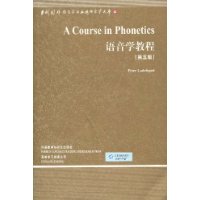本书是国际著名语音学大师Peter Ladefoged教授撰写的语音学入门教材,重点介绍发音语音学,同时也着重介绍了如何在探讨发音的过程中入声学语音学和感知语音学方面的考察。本书自1975年初版面世以来,已历经4个版次的修订,成为使用最广、影响最大的语音学基础教材之一,此次出版的即为2006年最新修订版。书中的讲解力求简明扼要、直截了当,非常适合初学者学习。
本书配有一张多媒体光盘,里面有使用本书所需的各种图表、录音、录像以及国际音标表中所有符号的发音。光盘里还包括本书的姊妹篇Vowelsand Consonants一书的光盘内容,可供使用时参考。
插图:

no proper nouns. As before, many of the sounds occur in new combinations, which means that they have slightly different patterns. But if you start with the more obvious sounds and use your knowledge of possible English words, you should be able to succeed. Many readers of earlier editions of this book have already done so.
The spectrograms that have been used to illustrate this chapter So far are called wide-band spectrograms. They are very accurate in the time dimension. They show each vibration of the vocal folds as a separate vertical line and indi- cate the precise moment of a stop burst with a vertical spike. But they are less accurate in the frequency dimension. There are usually several component fre- quencies present in a single formant, all of them lumped together in one wide band on the spectrogram.
It is a fact of physics that one can know either fairly precisely when a sound occurred or, to a comparable degree of accuracy, what its frequency is. This should be intuitively clear when you recall that knowing the frequency of a sound involves observing the variations in air pressure over a period of time. This period of time has to be long enough to ensure observations of a number of repetitions of the variations in air pressure. You can either know that a pulse from the vocal folds has happened (producing the vertical voicing striation in all the spectrograms we have considered so far), or, if the piece of the sound wave being analyzed contains two or three pulses of the vocal folds, you can tell how far apart they are and hence know the frequency,
Spectrograms that are more accurate in the frequency dimension (at the expense of accuracy in the time dimension) are called narrow-band spectro- grams. Figure 8.16 shows both wide- and narrow-band spectrograms of the question Is Pat sad, or mad? In the wide-band spectrogram, there are sharp spikes at the release of each stop, for example, for the [ d ] at the end of the utter- ance. The spikes are smeared in the time dimension in the narrow-band spectro- gram. But the frequencies that compose each formant are visible.
When the vocal folds vibrate, they produce what are called harmonics of their fundamental frequency of vibration. Harmonics are vibrations at whole-number multiples of the fundamental frequency. Thus when the vocal folds are vibrating at 100 Hz, they produce harmonics at 200, 300, 400 Hz, etc. In a given vowel, the particular harmonics evident are those that correspond to the resonances of the vocal tract shape occurring in that vowel. I have put two small white squares in the middle of the fifth, tenth, and fifteenth harmonics in the middle of the vowels in sad and mad. The vocal folds are vibrating at about 118 Hz in sad, so the fifth harmonic has a frequency of 5 x 118 = 190 Hz, the tenth harmonic a frequency of 1180 Hz, and the fifteenth harmonic a frequency of 1770 Hz.


